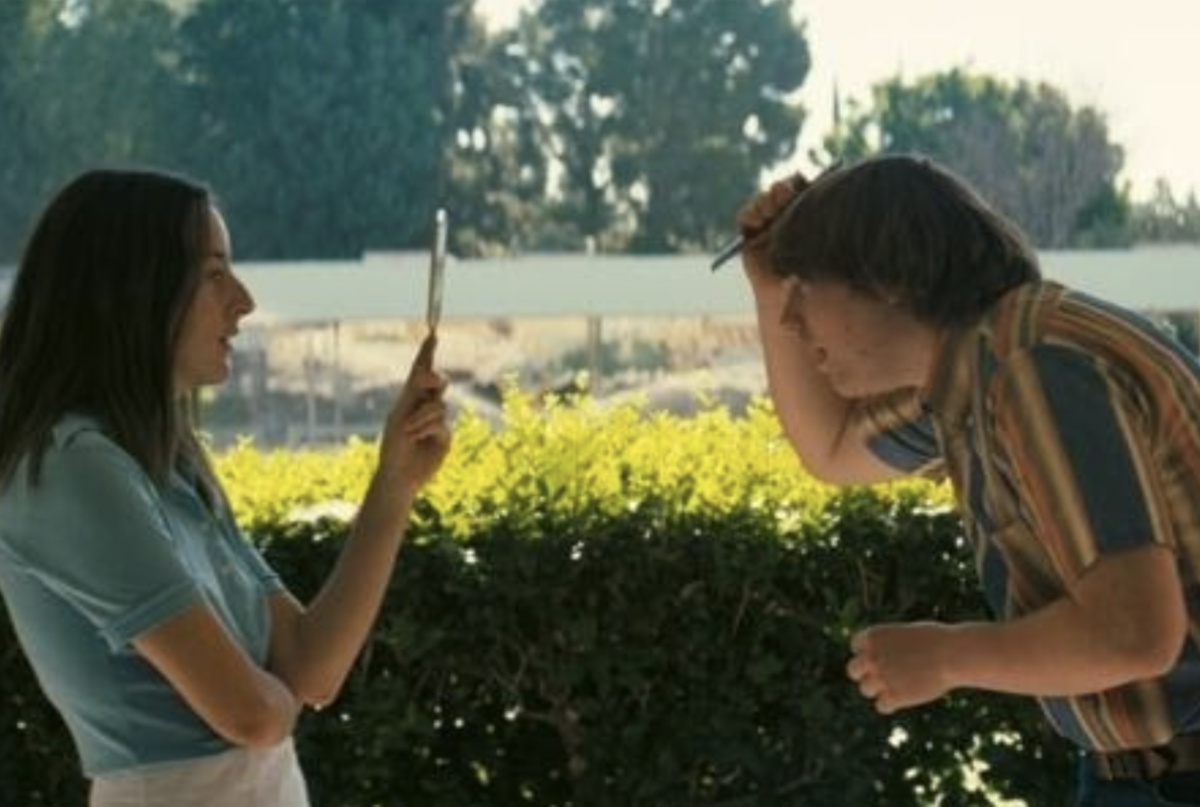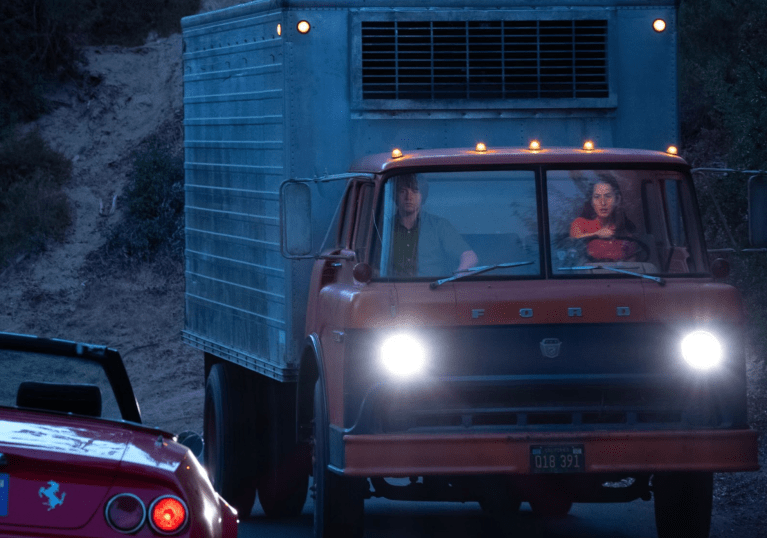When acclaimed director Paul Thomas Anderson told Alana Haim — the baby sister of pop-rock band HAIM — he was going to put her in a movie, she assumed he’d named a character after her, or at best, written her in as a spirited extra. Haim was as stunned as the public was to learn that she’d instead be co-starring alongside gauche teenager Cooper Hoffman in Anderson’s third filmic love letter to the San Fernando Valley. The 2021 coming-of-age comedy-drama, “Licorice Pizza,” has been nominated for “Best Picture – Musical/Comedy” and “Best Screenplay Motion Picture” at this year’s Golden Globes.
Anderson’s choice to cast two first-time actors as co-stars (and Haim’s entire, real-life family) in an ensemble film replete with Hollywood big names was certainly unconventional. However, these budding stars do not disappoint, fleshing out their characters and creating a thoroughly believable romance. Haim and Hoffman’s performances paired with Anderson’s picture-book reimagination of ’70s Encino make “Licorice Pizza” a success, even in spite of its unsavory relational dynamics and heavy-handed signposting.
Anderson’s film is not entirely concerned with plot as an organizing device — taking after Mumblecore in this orientation as well as in its naturalistic dialogue and allusive content. Still, the general storyline is as follows: overgrown child actor Gary Valentine (Hoffman) pines after turbulent young woman Alana Kane (Haim), and the two ebb and flow in their closeness as they embark on a series of loosely interconnected shenanigans. These range from selling egomaniac Jon Peters (Bradley Cooper) a water bed to filming closeted councilman Joel Wachs’ (Benny Safdie) integrity campaign. By the film’s close, the two ever-sprinting space cadets settle into a sweet but unsettling romance. In the spaces between this web of Alana and Gary’s situationship, Anderson packs a troop of latchkey kid entrepreneurs, absurdist cameos and a sordid backdrop of the 1973 oil crisis.
Though Anderson is not as novel as some perceive him to be with his homage-to-home, ‘hangout’ style — see Greta Gerwig’s “Ladybird,” Mike Mills’ “Twentieth Century Women” and Pete Davidson’s “King of Staten Island” — the bizarre side plots that ensue in “Licorice Pizza,” unlike those in many films in this style, leave viewers exhilarated rather than bored. Impressively, Haim learned to drive stick shift for a nerve-wracking scene in which Alana has to maneuver a truck down a whirling hill road in order to restart its engine and lead her crew of adolescent salesmen away from a presumably cracked-out Jon Peters. Her effort pays off in an energetic segment that thoroughly entertains and that won “Best Scene” at the St. Louis Gateway Film Critics Association Awards. In an earlier sequence, Gary and his fellow child stars — who are comically much younger and more adorable than he — perform a farcical number inspired by Melville Shavelson’s “Yours, Mine, and Ours” (1968). These few minutes are seemingly pointless, but they ingeniously contribute to Gary’s characterization and provide welcome amusement.
Unfortunately, not all of these side plots are winners, as one never really justifies itself. Sleazy peripheral character Jerry Frick (John Michael Higgins) has proved controversial among critical and general audiences alike. Frick is the white owner of a kitschy Japanese restaurant who repeatedly performs racist parodies of his insinuatingly-interchangeable Japanese wives’ (Yumi Mizui and Megumi Anjo) speech. In a scene wherein Alana and Gary pitch their waterbed advertisement to Frick for placement in his restaurant, Gary greets Frick’s presumed spouse as “Mioko” — Frick’s previous wife, whom we meet earlier in the film — and Frick corrects him, “No, no, no, Mioko’s gone. This is my new wife, Kimiko.” While some interpret Frick as a parody himself of the middle-aged, white male scumbag who glibly imitates and appropriates Japanese culture, others have simply called this bit “cheap” humor on Anderson’s part. Despite Anderson’s defense that he was trying to depict racist attitudes of the time, one can’t help but look at his myriad other successful worldbuilding tactics as easy alternatives to this unnecessary, flippant invocation of tired stereotypes.

Despite its centrality to the film, Alana and Gary’s romance too has its deficiencies. While critics have largely come to defend the young characters’ 10-year age gap, arguing that the “chastity” and “sweetness” of the relationship make it acceptable, it is not something viewers can or should get past. 25-year-old Alana meets 15-year-old Gary at his high school picture day, accompanies him to New York as his chaperone and for most of the film, treats him like a pesky kid. Thus, while Gary’s sheepish crush and early declaration, “I met the girl I’m going to marry one day” are endearing, there is nothing “chaste” or “sweet” about Alana flashing Gary while his little brother is home, or mouthing off, “If you tell me to make [the sales call] sexy, I’ll make it fucking horny” (notably the only time Alana tragically verges on manic pixie dream girl).
Anderson’s case for the romance is not aided by the actors’ age gap either; Haim turned 30 in December, and Hoffman is just 18. Were the genders reversed, as they are in Taylor Swift’s recent short film for her eponymous song, “All Too Well,” Anderson’s love story would likely be taking more heat. Viewers of Swift’s autobiographical short film were disturbed by a 30-year-old Dylan O’Brien filming intimate scenes with a 19-year-old Sadie Sink, just as Swift had intended in order to highlight how she’d been groomed in a past relationship. Meanwhile, Haim and Hoffman’s casting has largely escaped the censure of the public. Sweeter moments like Gary carrying a drunken Alana to safety after she falls from a Hollywood creep’s motorcycle or the two’s clumsily affectionate embrace near the film’s conclusion make it difficult not to root for them. Yet this is precisely what disturbs viewers; in actuality, they wind up ignoring the blatantly problematic fact that Gary is a minor, and though the two never share a sex scene, this renders any romance between them reprehensible.
Luckily, this has little bearing on the quality of Haim and Hoffman’s performances, which rightfully earned them both Golden Globe nominations. As first-time actors, they are playful but always in total control; their magnetism makes every verbal exchange, mood shift and look of yearning entirely convincing. Anderson recalled that while filming a scene with her sister Danielle in which both are supposed to be stoned, Haim altered her facial expression completely in a matter of seconds; as viewers, we easily buy that she did, in fact, just smoke an entire joint. When her denial of her infatuation with Gary finally relents, her demeanor similarly shifts instantaneously, and her desire is all but physically palpable. Her fleeting passions, mirrored in her ever-changing wardrobe and shots of her in shadow, read as genuine though they are short-lived, and her dialogue — often improvised — is delivered with simultaneous ease and conviction. On a quasi-date with casting director Jack Holden (Sean Penn), who is loosely based on Oscar-winning actor William Holden, Alana asks Holden of his speech, “Is this lines, or is this real?” We end up asking ourselves this same question whenever Alana delivers iconic quips like, “Fuck off, teenagers!” and “Stop thinking things, Este, you’re such a thinker!”
Meanwhile, Hoffman’s suave charm complements Haim’s raw allure. He is unfazed by her rejections and never abjures his commitment to her, though in a pleasant surprise given his puppy-dog nature, he does not put up with any of her teasing or taunting. When she lashes out at him, he does not indulge her biting remarks about his immaturity or not being “cool,” but rather removes himself, allowing her the space to come back to him. He respectably tries to wear the pants even if they don’t quite fit yet — literally, in a scene at the tailor — and always maintains geniality in the face of others’ derision. This self-assuredness never reads as cocky (though perhaps a bit naive), and we grow to respect Gary moreso than expected given his age. Though no performance in “Licorice Pizza” can truly outshine Haim’s, Hoffman’s certainly rivals it, and viewers leave the theater eager to see more of him.
If Haim and Hoffman’s phenomenal breakout performances are not enticing enough, Anderson serves a picture-perfect slice of the ’70s on a gaudy paper plate. Corduroy and blues rock abound, and Gary capitalizes on the emergence of the water bed and the triumphant return of the pinball machine. The film’s production team even used ’70s processes to create the film; vintage glass produces softer images, and 35 mm film creates more unique and varied color. Whereas Tarantino’s “Once Upon a Time in Hollywood” indulges in Hollywood’s spirit of self-aggrandizement, Anderson’s “Licorice Pizza” reveres the suburban magic of the San Fernando Valley. Details like a Cheyenne board game in Gary’s dining room, a storefront littered with cheap bicycles and a crowded burger joint envelop us within Alana and Gary’s retro milieu.
The film’s only cinematographic shortfall is Anderson’s heavy-handed running sequences. During Alana and Gary’s final race toward one another, Anderson flashes back to a prior sprint undertaken by Alana to retrieve Gary from the police station; many audience members likely would have connected the two images on their own, and thus Anderson’s interference registers as disruptive rather than subtly directive. Still, Alana’s shift in demeanor when she is running alongside Gary as opposed to in pursuit of him is heartwarming.
Ultimately, while “Licorice Pizza” has been justly criticized for Anderson’s more objectionable decisions, it is still an enchanting picture tinted in rosy nostalgia, and Haim and Hoffman have every reason to take pride in the final product.
Editor’s Note: This article is a review and includes subjective opinions, thoughts and critiques.
